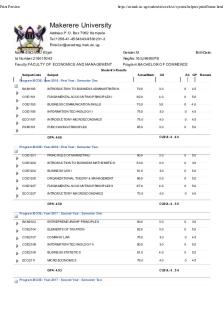Experiment 26 Results only PDF

| Title | Experiment 26 Results only |
|---|---|
| Course | General Chemistry II/Lab |
| Institution | Nova Southeastern University |
| Pages | 4 |
| File Size | 287.3 KB |
| File Type | |
| Total Downloads | 85 |
| Total Views | 123 |
Summary
Experiment 26...
Description
Results:
Figure 1. ln Ksp Vs. 1/T (K-1) 0
0
0
0
0
0
0
0
0
0
-1
Ln (Ksp)
-2
f(x) = − 8051.1 x + 22.88 R² = 0.99
-3
-4
-5
y = -8051.1x + 22.88 R² = 0.9903
-6
-7
1/T(K-1)
Sample of Calculations: Volume of HCl added ( mL )=buret reading , final (mL)−buret reading ,initial (mL) 22.8− 0=22.8 Temperature , T ( K )=℃+273.15 57 + 273.15 =330.15
1 −1 1 ( K )= T Temperature ( K ) 1 =3.03 × 10−3 330.15 1 −1 (K ) T 1000
0.174 × Moles of HClused ( mol )=
0.174 ×
1 ( K −1) 3.03 × 10−3 =3.9672 1000
Moles of HClused (mol ) 2 ¿ Moles of B4 O 5 (OH )4
2−¿ ( mol ) =
3.9672 =1.9836 2 B 4 O 5 ( OH ) 4 ¿ ¿3 Solubility product , K sp =4 ׿ ¿ 4 × ( 1.9836 )3=2.50 × 108 ln ( K sp) =ln (K sp ) ln ( 2.50 ×108) =19.336
( )
kJ = ∆H° mol
−∆ H ° ×−8.314 R 1000
−8.05 × 105 ×−8.314 =66.936 1000 ∆S
( molJ × K )= ∆RS ×8.314
43.603 ×8.314 =556.506 H° ∆ G , ( kJ ) at 298 K = ¿
kJ ( mol )−298 × ∆ S ( molJ × K) 1000
66.936 −298 × 556.506 =−98.90 1000
Conclusion: The objective of the experiment was to standardize a hydrochloric acid solution, to determine the solubility product of borax as a function of temperature and the standard free energy, standard enthalpy, and standard entropy changes for the dissolution of borax in an aqueous solution. In the experiment, the 3 temperatures used as the experimental conditions, were cold, hot, and room temperature. In my experiment, the molar solubility of borax of the hot, room, and cold samples respectably read, 0.39672. 0.13224, 0.07656. As the temperature increased, the solubility of the solution increased. In the experiment, when the solution was submerged in the hot environment, it allowed the particles of borax to diffuse thoroughly into the solvent. In the Gibbs free energy equation, temperature plays in important role in determining free energy and spontaneity. At low temperatures, the reaction has a higher probability of being spontaneous and at higher temperatures the reaction had a lower possibility of being spontaneous (non-spontaneous)....
Similar Free PDFs

Experiment 26 Results only
- 4 Pages

Experiment 26 resluts only
- 5 Pages

Results
- 3 Pages

Provisional Results
- 2 Pages

Eli Results
- 6 Pages

Results section
- 3 Pages

Chapter 26 - Lecture notes 26
- 5 Pages

TEMA 26 bioquimica - Apuntes 26
- 1 Pages
Popular Institutions
- Tinajero National High School - Annex
- Politeknik Caltex Riau
- Yokohama City University
- SGT University
- University of Al-Qadisiyah
- Divine Word College of Vigan
- Techniek College Rotterdam
- Universidade de Santiago
- Universiti Teknologi MARA Cawangan Johor Kampus Pasir Gudang
- Poltekkes Kemenkes Yogyakarta
- Baguio City National High School
- Colegio san marcos
- preparatoria uno
- Centro de Bachillerato Tecnológico Industrial y de Servicios No. 107
- Dalian Maritime University
- Quang Trung Secondary School
- Colegio Tecnológico en Informática
- Corporación Regional de Educación Superior
- Grupo CEDVA
- Dar Al Uloom University
- Centro de Estudios Preuniversitarios de la Universidad Nacional de Ingeniería
- 上智大学
- Aakash International School, Nuna Majara
- San Felipe Neri Catholic School
- Kang Chiao International School - New Taipei City
- Misamis Occidental National High School
- Institución Educativa Escuela Normal Juan Ladrilleros
- Kolehiyo ng Pantukan
- Batanes State College
- Instituto Continental
- Sekolah Menengah Kejuruan Kesehatan Kaltara (Tarakan)
- Colegio de La Inmaculada Concepcion - Cebu







